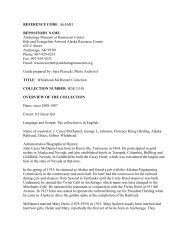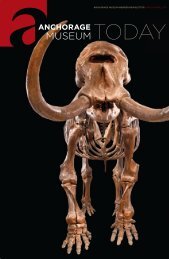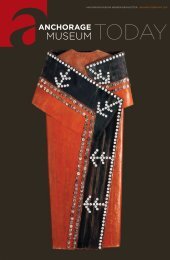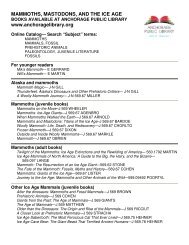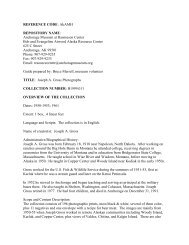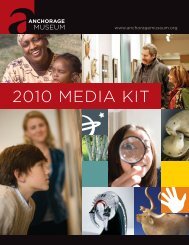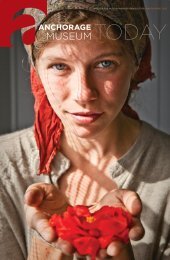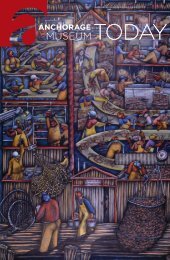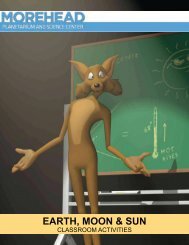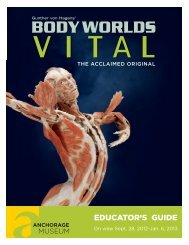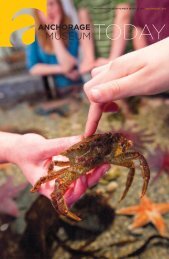Exhibition explores the relationship between art, science
Exhibition explores the relationship between art, science
Exhibition explores the relationship between art, science
You also want an ePaper? Increase the reach of your titles
YUMPU automatically turns print PDFs into web optimized ePapers that Google loves.
NEWS RELEASE<br />
FOR IMMEDIATE RELEASE<br />
Jan. 3, 2008<br />
Media Contact: Janet Asaro, (907) 343-6151<br />
<strong>Exhibition</strong> <strong>explores</strong> <strong>the</strong> <strong>relationship</strong> <strong>between</strong> <strong>art</strong>, <strong>science</strong><br />
and ethnography within <strong>the</strong> Yup’ik way of life<br />
“Yuungnaqpiallerput (The Way We Genuinely Live):<br />
Masterworks of Yup’ik Science and Survival”<br />
On view at <strong>the</strong> Anchorage Museum Feb. 3 through Oct. 26<br />
Opening reception 1 to 3 p.m. Sunday, Feb. 3,<br />
with a performance by <strong>the</strong> Kicaput Dancers<br />
The Yup’ik people have no word for <strong>science</strong> yet <strong>the</strong>ir tools were so well designed<br />
that <strong>the</strong>y allowed <strong>the</strong> Yupiit to live in a land no one else would inhabit. The exhibition<br />
“Yuungnaqpiallerput (The Way We Genuinely Live): Masterworks of Yup’ik Science<br />
and Survival” presents remarkable 19th and early 20 th century tools, containers, weapons,<br />
watercraft and clothing in an exploration of <strong>the</strong> scientific principles and processes that<br />
have allowed <strong>the</strong> Yup’ik people to survive in <strong>the</strong> sub-arctic tundra of <strong>the</strong> Bering Sea<br />
coast. The exhibition is on view Feb. 3 through Oct. 26.<br />
Featuring "masterworks" ranging from a needle made from a crane wing bone<br />
to elegant bentwood hunting hats, The Way We Genuinely Live elucidates <strong>the</strong> <strong>science</strong><br />
behind <strong>the</strong> design and technology of <strong>the</strong>se objects. Coming from <strong>the</strong> collections of 13<br />
museums in <strong>the</strong> U.S. and Germany, more than 200 exhibition objects are <strong>the</strong> legacy of <strong>the</strong><br />
intelligence and ingenuity of this ancient culture and illustrate <strong>the</strong> intimate <strong>relationship</strong><br />
<strong>between</strong> humans and <strong>the</strong>ir environment.<br />
The exhibition is based on knowledge shared by Yup’ik elders and takes visitors<br />
through <strong>the</strong> seasonal cycle of activities, showcasing tools and materials. At interactive<br />
<strong>science</strong> stations, visitors can engage in hands-on activities that show how and why<br />
things work. Video and audio programs document traditional activities as well as<br />
<strong>the</strong> construction of traditional Yup'ik tools. Not just a <strong>science</strong> exhibit, The Way We<br />
Genuinely Live is compelling in its presentation of <strong>the</strong> unique marriage <strong>between</strong> <strong>art</strong>,<br />
(more)
The Way We Genuinely Live, page 2 of 2<br />
<strong>science</strong> and ethnography. At <strong>the</strong> exhibition’s core is <strong>the</strong> recognition that <strong>the</strong> Yup’ik way<br />
of life – both past and present – is grounded in deep spiritual values and scientific<br />
principles.<br />
Curated by cultural anthropologist Ann Fienup-Riordan, The Way We Genuinely<br />
Live is a joint project of <strong>the</strong> Anchorage Museum and <strong>the</strong> Calista Elders Council,<br />
developed with <strong>the</strong> guidance of Yup'ik elders, scientists, and educators and with major<br />
support from <strong>the</strong> National Science Foundation. In 2009-2010, <strong>the</strong> exhibition will travel to<br />
museums in Fairbanks, Juneau, and Washington, DC. It premiered in September 2007 at<br />
<strong>the</strong> Yupiit Piciryarait Cultural Center and Museum in Be<strong>the</strong>l, Alaska.<br />
The exhibition was designed by Presentation Design Group of Eugene, Oregon.<br />
Video and audio programs were produced by KYUK of Be<strong>the</strong>l, and <strong>the</strong> interactive<br />
<strong>science</strong> stations were developed by <strong>the</strong> Oregon Museum of Science and Industry with<br />
advice from Yup’ik elders, staff from Anchorage’s Imaginarium Science Discovery<br />
Center and national experts in <strong>the</strong> field of informal <strong>science</strong> education. The Imaginarium<br />
also will host several sessions on Yup’ik Science during its 2008 Summer Science<br />
Camps.<br />
The museum gratefully acknowledges <strong>the</strong> support of <strong>the</strong> National Science<br />
Foundation, Totem Ocean Trailer Express, Nor<strong>the</strong>rn Air Cargo, Alaska Airlines, BP,<br />
ConocoPhillips Alaska, Calista Corporation, Anchorage Museum Foundation and <strong>the</strong><br />
Anchorage Museum Association.<br />
For more information, call (907) 343-6151.<br />
###
About <strong>the</strong> Curator<br />
of<br />
“Yuungnaqpiallerput (The Way We Genuinely Live):<br />
Masterworks of Yup’ik Science and Survival”<br />
Ann Fienup-Riordan, Ph.D.<br />
Ann Fienup-Riordan is a cultural anthropologist who has lived and worked in Alaska<br />
since 1973. Her books include The Nelson Island Eskimo (1983), Eskimo Essays (1990),<br />
Boundaries and Passages (1994), The Living Tradition of Yup'ik Masks (1996) and Wise Words<br />
of <strong>the</strong> Yup'ik People: We Talk to You because We Love You (2005).<br />
Between 1994 and 1996 she worked with <strong>the</strong> Anchorage Museum and <strong>the</strong> Coastal Yukon<br />
Mayors Association to develop <strong>the</strong> Yup'ik mask exhibit Agayuliyararput: Our Way of Making<br />
Prayer. From 1997 through 1999 she worked with Yup'ik elders exploring museum collections in<br />
a project sponsored by <strong>the</strong> National Science Foundation titled “Elders in Museums: Fieldwork<br />
Turned on Its Head.” She currently works documenting traditional knowledge with <strong>the</strong> Calista<br />
Elders Council, <strong>the</strong> primary heritage organization in southwest Alaska.<br />
In 2000, <strong>the</strong> Alaska Federation of Natives presented Fienup-Riordan with its President's<br />
Award for her work with Alaska Natives. She won <strong>the</strong> Governor's Award for Distinguished<br />
Humanist Educator in 2001.
NEWS RELEASE<br />
FOR IMMEDIATE RELEASE<br />
Jan. 3, 2007<br />
Media Contact: Janet Asaro, 343-6151<br />
The Anchorage Museum taps <strong>the</strong> power of <strong>the</strong> past with<br />
Yup’ik Science programs<br />
The Anchorage Museum presents a series of programs in conjunction with <strong>the</strong> exhibition<br />
Yuungnaqpiallerput (The Way We Genuinely Live): Masterworks of Yup’ik Science and<br />
Survival, on view Feb. 3 through Oct. 26, 2008<br />
Symposium<br />
Creating <strong>the</strong> <strong>Exhibition</strong> Yuungnaqpiallerput (The Way We Genuinely Live):<br />
Masterworks of Yup’ik Science and Survival<br />
9 a.m. to 5 p.m. Saturday, Feb. 2, Auditorium<br />
Moderator: Ann Fienup-Riordan, curator of Yuungnaqpiallerput (The Way We Genuinely<br />
Live): Masterworks of Yup’ik Science and Survival<br />
This one-day symposium <strong>explores</strong> <strong>the</strong> collaboration <strong>between</strong> Native experts and non-<br />
Native scholars resulting in this extraordinary exhibition. Through panel discussions and<br />
presentations, Yup’ik elders and museum professionals will share <strong>the</strong>ir experience of<br />
creating an exhibition that combines Yup’ik philosophy and perspective with western<br />
<strong>science</strong>.<br />
Invited speakers include Yup’ik tradition bearers and educators Paul John, Noah Andrew<br />
Sr., Mark John, Vivian Korthuis, Mary Pete, Theresa John, Es<strong>the</strong>r Ilutsik, Alice Rearden,<br />
Marie Meade, Elsie Ma<strong>the</strong>r and Joan Hamilton; humanities scholars and museum<br />
professionals Peter Bolz, Aron Crowell, and Suzi Jones; <strong>science</strong> center professionals<br />
Kathleen McLean, Greg Danner and Melissa Paugh; exhibition evaluator Beverly Serrell;<br />
and exhibition designer Michael Whitenack.<br />
Cost is $20 for members, $25 for non-members and $10 for students. Register by<br />
Wednesday, Jan. 30, at (907) 343-4326.<br />
This symposium is funded in p<strong>art</strong> by a grant from <strong>the</strong> Alaska Humanities Forum.<br />
(more)
Science programs, page 2 of 2<br />
Opening reception for Yuungnaqpiallerput, The Way We Genuinely Live:<br />
Masterworks of Yup’ik Science and Survival<br />
1 to 3 p.m. Sunday, Feb. 3<br />
Celebrate <strong>the</strong> opening of Yuungnaqpiallerput, The Way We Genuinely Live: Masterworks<br />
of Yup’ik Science and Survival at a public reception 1 to 3 p.m. Sunday, Feb. 3. The<br />
Kicaput Dancers will perform. This event is free and open to <strong>the</strong> public.<br />
Yup’ik Subsistence Tools Demonstration<br />
10 a.m. to 4 p.m. Feb. 5 through 9<br />
Noah Andrew and Jack Abraham demonstrate how to make Yup’ik hunting tools such as<br />
atlatl, bird spears and seal-hunting harpoons, during <strong>the</strong> opening week of <strong>the</strong> exhibition<br />
Yuungnaqpiallerput (The Way We Genuinely Live): Masterworks of Yup’ik Science and<br />
Survival. All demonstrations are included with museum admission.<br />
Science Outreach<br />
In p<strong>art</strong>nership with <strong>the</strong> Anchorage Museum <strong>the</strong> Imaginarium is offering <strong>science</strong> outreach<br />
programs on Yup’ik <strong>science</strong> and technology. Schools interested in <strong>the</strong> outreach programs<br />
can contact <strong>the</strong> Imaginarium at 276-3179 or email kbeckford@imaginarium.org. The<br />
Imaginarium will also host several sessions on Yup’ik <strong>science</strong> during Its 2008 Summer<br />
Science Camps.<br />
For more information on <strong>the</strong> Anchorage Museum’s Yup’ik Science programs call<br />
343-6323.<br />
# # #



